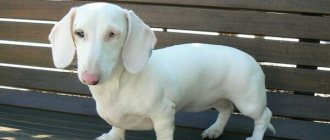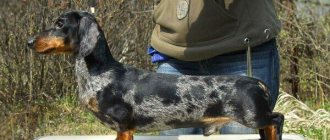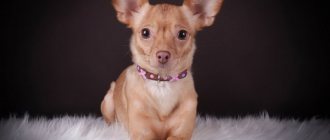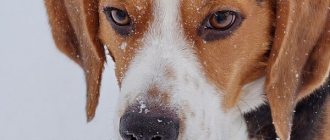The Dachshund is one of the most recognizable dog breeds.
Pets are divided based on characteristics.
They also differ in coat type.
Excellent hunters are increasingly becoming companion dogs and family pets.
In our article you will learn about breed standards, features of selection and cost of puppies.
Breed standard
The standard defines the breed according to 2 characteristics - size and coat.
By size:
- standard;
- dwarf;
- rabbit
By wool type:
- smooth-haired;
- long-haired;
- wire-haired.
There are 9 combinations of these characteristics. For example, a long-haired standard dachshund, a royal purebred, a dwarf smooth-haired or a wire-haired rabbit.
In most breeds, small representatives are not included separately in the standard . Sometimes too small a size or long hair, on the contrary, are recognized as defects at exhibitions.
This is the main difference between the standard for dachshunds - the approved sizes and type of coat.
Purchasing recommendations
When buying a dachshund puppy, you need to pay attention to the following criteria for choosing the right pet:
- If the dog is not shown at the exhibition unplanned, then it is recommended to give preference to “pet-class” puppies. Such an animal may have some minor disadvantages that prohibit its use in breeding. The cost of such a puppy is much lower, and averages 9-12 thousand rubles;
- “show class” rabbit or miniature dachshund puppies are intended to be raised for the purpose of being presented at exhibitions. Such an animal is distinguished not only by its excellent exterior, but also must have a certain temperament. Overly active and excitable dogs are difficult to control, so pre-show preparation can take a lot of time, money and effort. An overly calm and phlegmatic dog looks too lethargic in the ring. That is why it is best to purchase an animal of this class with the help of an experienced dog handler, and the price of a puppy in this case often exceeds 20-30 thousand rubles.
It is important to remember that even from a very promising puppy, you can get a titled dog or a champion pet only with full compliance with the maintenance regime and competent, timely upbringing.
Video
Photo of what it looks like
Standard individuals are easily recognizable.
These are short-legged, elongated dogs, with a proudly set head and floppy ears. Dachshunds are strong and muscular.
Mobile, despite the ratio of paw length to body length. They have a decisive and confident appearance.
There are no concessions for dwarf and rabbit dachshunds . They are characterized by the same breed appearance.
Tax standard in RKF
The RKF has adopted the FCI standard - the International Cynological Federation.
Head – the length of the skull and muzzle are approximately the same. The transition of the forehead to the muzzle is smooth. The muzzle tapers towards the nose.
The nose is noticeably developed. The lips fit tightly to the teeth and are colored to match the primary coat colors (black or brown). Scissor bite, firmly closed.
At exhibitions, special attention is paid to teeth. Quantity, availability and location are taken into account.
Age-related changes are recorded by veterinarians so that they are not considered a defect.
- The eyes are oval and widely spaced. The color, like the lips, is related to the basic coat color - black-brown for black dogs, reddish for brown dogs.
- Ears. High rise. Long, rounded at the ends, without folds. When at rest, parallel to the cheekbones.
- The neck expands from the head to the body. Long and flexible. The skin is dry, with minimal folds possible. The withers are noticeably pronounced, more so in males.
- The back is straight or slightly sloping towards the croup, muscular. Long and strong loin. Dips at the withers and curvature of the spine are unacceptable.
- The croup is wide, a slight slope is possible.
- The chest is wide, oval. It protrudes so that small depressions form on the sides. The paws cover the lowest point of the sternum.
- The ribs are laid back. Normal length is about half of the entire body. The belly is tucked in.
- The tail is a continuation of the top line, tapering towards the tip. Allow a slight bend at the end.
The forelimbs are directed straight and forward . Strong bones, muscular. Elbows are pulled back. Fingers in a ball, with plump pads. The fifth finger is there, no need to remove it.
The hind limbs are parallel and not too narrow. The joints are well defined. The thighs are muscular. Fingers are balled up and arched.
The skin fits tightly to the body . The number of folds is minimal.
Health
The average lifespan of a Dachshund ranges from 14–17 years, but the breed is prone to a number of diseases. It is worth understanding that problems with the spine affect almost all representatives of the breed, especially in old age. There are a number of specific diseases that are diagnosed in almost many dachshund dogs:
- Achondroplasia is, simply put, dwarfism, which is both a disease and a breed trait. That is, an elongated body, against the background of shortened legs, is a pathology that leads to a number of consequences.
- Swimmer's syndrome is a disease that only Dachshunds are prone to; in veterinary medicine, it is referred to as osteoporosis of puppies. Babies 2-3 weeks old do not walk, but crawl, making characteristic movements with their paws. Additional risk factors include obesity and slippery floor surfaces.
- Displacement and deformation of intervertebral discs , which lead to pinched nerve endings and paralysis of the hind limbs.
- Slipped disc syndrome is a spinal disease that also leads to pinched nerve processes and paralysis. It is worth understanding that the syndrome is a breed ailment of Dachshunds and is not related to their physique. Recent studies have found that paralysis of a dog in old age can be predicted when the four-legged dog is only one year old. If a young dog has calcification, the likelihood of developing paralysis (eventually) is almost 100%.
- Idiopathic epilepsy - expressed by ataxia, vomiting, in severe cases, tremor and involuntary defecation.
- Pigmentary skin dystrophy - leads to coarsening, thickening and darkening of the skin, which gathers in folds under the armpits, on the inner thighs, behind the ears, etc.
Dachshunds are also prone to a number of “common” canine ailments that can develop at any age:
- Alopecia.
- Cataract.
- Heart pathologies.
- Diabetes.
- Pathologies of the kidneys and urinary tract.
- Epilepsy.
Important! Dachshunds are prone to obesity! Strictly monitor your child’s weight gain and balanced diet!
Pet character
Dachshunds are friendly dogs, suitable as companions and for families with children . Hardy, will withstand long walks for 1-2 hours. Not aggressive towards children.
They need close contact with the owner and often choose a “favorite”. They do not tolerate loneliness well, chew furniture, and howl.
Bred for hunting, they exhibit instincts and chase selected prey while walking . They often run away from their owner in the heat of the chase and get lost. Or they damage furniture and clothes when they dig imaginary holes. This feature is corrected by education.
Dachshunds are successfully trained. They learn circus acts and serious commands with equal success - search, tracking, chasing. These dogs are also stubborn, independent, and sometimes stubborn.
These traits were preserved from their ancestors, because the dog had to calculate some actions on its own.
Capable of protecting the owner . They evaluate their abilities and size before a fight.
Dachshunds have a sonorous and loud bark that does not match their size. Only he alone scares away intruders from a person or from an apartment.
Expert opinion
Kozhevin Semyon Kirillovich
Expert dog handler.
The character is very interesting, the dachshund knows how to think and make decisions. Barks when necessary. She ran away a couple of times, but returned on her own. A hunting dog, it can track foxes and raccoons. But at the same time, he doesn’t rush at cats and dogs or choke him. He has a good, kind attitude towards people, and loves children very much. Swims with them, and in winter rides down the slides.
Grooming
Smooth-haired pets do not require special care. It is enough to wipe them with a terry towel or mitten once a day.
Long-haired dogs need to be brushed with a special brush daily. Wire-haired individuals require special care.
They need to periodically remove dead hairs from their fur and trim them. This must be done manually, using scissors and a furminator. If this is not done, your pet may get a skin disease.
Adults need to be bathed once every 3-4 months. Small puppies under six months should not be bathed at all. You just need to wash your paws after a walk.
Advantages and disadvantages
Positive traits:
- Smart and savvy. They teach a command in 30-40 repetitions, they obey the first time.
- Friendly. Suitable for single people or large families.
- Active and energetic. They love to walk, are hardy, and playful. They are curious and ready to participate in the owner’s affairs.
- Brave hunting dogs.
- Funny appearance. Pleasant to the touch, with moving facial expressions.
- Feel the mood of the owner.
- Long-lived. With a balanced diet and good care, they live up to 17 years.
Negative qualities:
- With a lack of attention, furniture, clothes and shoes are damaged.
- They dig holes on walks. If you bring a dog to your dacha or garden, it will dig up the entire area.
- Long ears are susceptible to disease and require constant monitoring and care.
- The long spine is also susceptible to disease. Needs strengthening training - independent descent and ascent of stairs, carrying weights in the teeth and on the back.
- They love to eat and are prone to obesity.
- Due to worker training, hunting calls are sometimes dangerous to other animals. They can strangle cats and small dogs.
A little history
This breed has its roots in the depths of history, since images of dachshunds are found even on the papyri of ancient Egypt. And this is at least 2 thousand years ago. In this regard, scientists believe that the homeland of the dachshund is Egypt. As for the ancestors of the modern dachshund breed, its basis is considered to be short hunting dogs.
At the initial stages of breeding this breed, personal preferences, as well as the concepts of tastes exclusively of breeders, were taken as a basis. Since 1870, this approach was replaced by the requirements that were put forward for this breed of dog, otherwise it would hardly be possible to register this breed officially. At the beginning of the 18th century, this breed appeared in our country.
Dog parameters
Proportions are important for the breed.
Here are 2 main ones:
- 1/3 of the height at the withers is the distance from the bottom of the chest to the ground.
- 1.7-1.8:1 – the ratio of the oblique length of the body to the height at the withers.
- Oblique length of the body - from the extreme point of the chest to the ischial bones.
| Standard | Dwarf | Rabbit | |
| Weight | 7-9 kg | 4-5kg | Up to 3.5 kg |
| Height | Up to 30 cm | 14-20 cm | Up to 15 cm |
| Bust | From 35 cm | 30-35 cm | 30 cm |
The most important indicators for dachshunds are chest girth and weight; they are specified in the standard. So, the dog’s weight should not exceed 9 kg, chest circumference 36 cm.
Boys and girls differ in size, girls are smaller.
Measurements of dwarfs and rabbits are carried out no earlier than 1.5 years.
Wool
According to the standard, taxes are:
- Shorthaired . The most common variety. The coat is up to 2 cm, smooth and shiny. No bald patches, slight feathering on the lower part of the tail is possible. The fur fits tightly to the body and is thick. In winter it is slightly longer than in summer.
- Long-haired . The coat has an undercoat, is longer on the underparts and throat, and is straight. Feathers on the back of the limbs and on the lower part of the tail, fringe on the ears. The wool is soft and pleasant to the touch. It is believed that longhair appeared from crossing dogs with other hunting breeds. For example, spaniels and cops.
- Wirehaired . Rarely found in Russia. The coat is thick, dense, with undercoat. Shorter on the head, ears and limbs than on the body. The wool feels like bristles. The muzzle has prominent eyebrows, a beard and a mustache. The breeding of wire-haired dachshunds was required to improve hunting parameters. This wool is almost waterproof and resistant to cold. Wirehaired Dachshunds are the result of crossing with the Dandie Dinmont Terrier.
Color
- Single color . Shades of red range from straw-red to dark red and dark brown. There may be black hairs and occasional white spots. The more intense the red color, the better.
- Two-color. The main color is black or brown. Tan marks of coffee, chocolate, fawn color on the front of the chest, above the eyes, on the paws, on the sides of the muzzle. Small white spots may occur. It is customary to call two-colored dachshunds black and tan and chocolate - the main color is brown, the markings are fawn.
- Tiger and marble. Brindle - red with dark markings, marbled - black, red, gray with gray or beige spots. The spots should not be large; the presence of white spots is a defect.
How to choose a puppy?
Puppies are adopted at the age of 2 months. At this time, they are already weaned off milk and have the necessary vaccinations.
To purchase a purebred dog, contact nurseries and breeders . Their dogs have planned puppies, with the best males, and they take care of their health and condition.
It is advisable to look at the puppy’s parents, their pedigrees and passports. The stronger the breed characteristics of the mother, the more stable the psyche, the better the health and appearance of the offspring.
NOTE!
Examine the puppy you like, paying attention to the ears, eyes and nose.
There should be no strange discharge or unpleasant odor. The belly should not be very swollen, the coat should be smooth and shiny.
Observe your gait and coordination. A little clumsiness is possible. A good puppy is active and shows interest in others.
Do not adopt aggressive puppies that bite or puppies with tucked tails that are uncooperative and hide from hands..
As with any other dog, education and training must be done from puppyhood.
Dachshunds are smart and active dogs . Long walks are possible with them, they play with children, and are successfully trained. Our article will help you learn more about the appearance and character of these animals and choose a beautiful and thoroughbred pet for yourself.
Hunting
The first German name of the breed is Dachshund , which speaks for itself, because in direct translation it sounds like one at war with a badger. The breed was bred for burrow work and the appearance of the dogs emphasizes this “trajectory”. It is interesting that every dachshund puppy is born a companion, and then, depending on training, he becomes a miner or a hound. In rare cases, Dachshunds are used for feeding game from the water, rutting ungulates and wild boars. In general terms, representatives of the breed can be called gambling hunters; hunting for the sake of “sporting interest” does not inspire them.
Note! Practice proves that any Dachshund, regardless of origin, can be trained to work in a hole.
Traditional burrow hunting includes several stages of training. Dogs train in artificial burrows and learn to escape from opponents' grips. At the same stage, the dog’s courage and its desire to go into the hole are assessed. Training to drive an animal and to feed a wounded animal is fundamentally different, since the four-legged animal should not get into a fight. Controlling aggression towards an animal is a difficult task and not every dog can cope with it.











